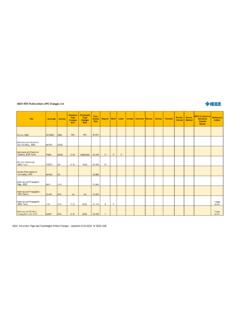Transcription of RESILIENT THINKING: TAMING NEGATIVE EMOTIONS
1 RESILIENT THINKING: TAMING NEGATIVE EMOTIONS . By Anne Brafford | | HOW STRESS CAN HOLD US BACK. T he problem with stress in our everyday lives is not that it occurs since it can be useful for energy, attention, and performance. Problems can arise when we're reactive to small, bandwidth for thinking isn't available, we can lose the ability to mentally process effectively, literally drop IQ points, and become more impulsive and lacking in self-control. daily stressors, when we get stuck in a Stress Spiral, or when stress undermines our confidence. RESILIENT thinking can help THE CONFIDENCE GAP. us overcome all of these well-being obstacles. Low self-confidence in our ability to be effective can cause depression and other mental health conditions. On the other EMOTIONAL REACTIVITY TO DAILY HASSLES hand, among the biggest contributors to well-being is making Every day, lawyers confront a stream of hassles that, individually, progress toward goals that are meaningful to us.
2 But fear and seem small and harmless. Research shows, though, that if we anxiety about failing and looking dumb often can become an don't effectively manage our emotional response, these small obstacle to pursuit of growth opportunities and ambitious irritants can accumulate and create big problems. Research has goals. We may hold ourselves back, waiting to feel completely found that our response style to common, minor stressors is a confident and for the NEGATIVE self-talk warning us about stronger predictor of depressed mood and anxiety than total potential failure to quiet down before we jump in and try. stress (Felsten, 2004). Stressors studied included many minor, Thinking that we have to feel fully confident and free of stress everyday things like not finishing a task, hurrying to meet a and anxiety before trying to achieve our goals is a self-defeat- deadline, being interrupted, being criticized or ignored, forget- ing perspective called the confidence gap (Harris, 2011).
3 Ting something, having difficulty in traffic, and misplacing some- thing. The more stressful people rated each example (called stress reactivity), the more vulnerable they were to mood disturbances, THE STRESS SPIRAL Stressful Situation which are precursors to more serious mental and physical health conditions. You're likely prone to stress reactivity if you would de- scribe yourself as having a hard time relaxing It's Urgent & Important and basically anxious with tendencies to feel and You're Responsible guilty, slighted, and moody. THE CHRONIC STRESS SPIRAL Put In Extra Effort &. We also can get caught in downward Stress Neglect Your Needs Spirals (Livheim et al., 2018). A key cause for this is that we humans have very limited cognitive space or mental bandwidth the brainpower needed to manage our demand- Payoff or Reward ing daily lives (Mullainathan & Shafir, 2013). Tunneling happens when we become so preoccupied with a stressor that it consumes excessive mental bandwidth, leaving little Your Success Reinforces Your Pattern capacity for anything else.
4 Because our full of Extra Effort & Neglect of Self Anne M. Brafford RESILIENT THINKING / 1. RESILIENT THINKING WORKSHEET. We are what we think. All that we are arises with our thoughts. With our thoughts, we make the world. Buddha RESILIENT RESPONDING TO STRESS. Don't Believe Everything You Think. A key insight from resil- Iceberg Beliefs. These automatic thoughts often occur so fast ience research has been life-changing for many: Stress is not that we're not consciously aware of them. This means that we triggered by adverse external events but by our avalanche of need to really slow down to detect them. We also should explore thoughts, predictions, and interpretations that adverse events deeply-held beliefs (called iceberg beliefs ) that may be trigger- trigger. RESILIENT thinking starts with learning to separate our ing our NEGATIVE thoughts. High-achieving professionals often thoughts from the emotional and behavioral consequences of have iceberg beliefs like these (see Wiesssman, 1979): those thoughts and cultivating optimism.
5 Mistakes will make people think less of me. Pessimism vs. Optimism. Our appraisal style is how we tend to My life is wasted unless I'm successful. interpret stressful situations. It's important because it affects our If I don't set the highest standards for myself, I'll be a medi- level of stress reactivity and mental health. ocre person. Pessimistic Appraisal Style: We have a pessimistic appraisal To be a worthwhile person, I must truly excel in at least one style if we habitually interpret challenging events in an major aspect of my life. overly NEGATIVE way. We may consistently overestimate how If I don't always do well, people will lose respect for me. bad the consequences will be, overestimate the probability I must be a useful, productive person or life has no purpose. of those bad consequences occurring, and/or underestimate People who have good ideas are more worthy than people our ability to effectively respond. who don't. Optimistic Appraisal Style: We have an optimistic appraisal People who have habits of thought like these are more likely to style when our habits of thought are more positive and experience depression and anxiety.
6 Hopeful when considering the likely consequences of chal- Common Thought-Emotion Links. The precise way that our self- lenges and our ability to cope. talk plays out is unique to each of us but we can categorize Realistic Optimism. RESILIENT thinking is not overly pessi- types of self-talk that trigger specific EMOTIONS . Understanding mistic or overly optimistic. It's a flexible approach in which these connections can help us identify and process our EMOTIONS we realistically appraise challenges in ways that favor and figure out how to respond constructively. The table below optimistic explanations and predictions when the knowable shows common thought-emotion links (Reivich & Shatte, 2002). (often fuzzy ) facts allow that perspective. THOUGHT EMOTION. Becoming Aware Of Our Thought-Emotion Links. Stressful events often trigger automatic streams of NEGATIVE self-talk that My rights have been violated. Anger stir up NEGATIVE EMOTIONS . RESILIENT thinking requires that we pay closer attention to our automatic thoughts so that we can I've experienced a loss.
7 Sadness, depression modify them before they run wild and EMOTIONS carry us away. I have violated a commitment to you Guilt To prepare to respond effectively to stress, it's helpful to identify or my own standards for myself. our common triggers and self-talk habits: Something bad is going to happen. Anxiety, fear What circumstances often trigger you to feel anxiety, panic, self-doubt, anger, irritation, guilt, shame, or embarrassment? Others know I did something badly. Embarrassment When NEGATIVE self-talk starts up, what is it often saying? Anne M. Brafford RESILIENT THINKING / 2. RESILIENT THINKING WORKSHEET. She stood in the storm, and when the wind did not blow her way, she adjusted the sails. Elizabeth Edwards 6 Steps for RESILIENT Thinking T he overarching aim in RESILIENT thinking is psychological and regulatory flexibility, which is defined as: Step 2: Label The Emotion It may sound weird, but labeling our NEGATIVE EMOTIONS ( , This The ability to be consciously aware of our feeling I'm experiencing is anxiety ) and being able to differ- internal experience and, based on situational entiate between them ( , This feeling is anxiety, not anger or demands, to flexibly choose, change, or persist in sadness ) contributes to well-being (Kalokerinos et al.)
8 , 2019) and behaviors that aligns with our values and goals. down-regulates our physiological stress response (by, for example, quieting the amygdala; Lieberman et al., 2008, 2011). Labeling (Aldao et al. 2015; Blanke et al., 2019; Flaxman & Bond, 2010;. also may reduce the likelihood of misattribution , a mistake Sutcliffe et al., 2018; Tyndall et al., 2018; Wersebe et al. 2018). about the cause of our EMOTIONS (You might be tired, not mad.). Flexibility requires: (1) an ability to avoid being carried away by The more specific we can be in differentiating our emotional our EMOTIONS by cultivating a conscious awareness of our inner experiences, the more powerful the effect. experience, (2) an ability to read the situation to guide the choice To carry out this step, you can try the following: of self-regulation strategy, (3) a repertoire of self-regulatory skills and behaviors from which to choose, and (4) an ability to change 1. Focus your attention on the most intense emotion you're strategies if needed (Southwick et al.
9 , 2014). Below are six steps experiencing. to get started on building your psychological flexibility. 2. Label the emotion as best you can without identifying with it ( , I'm having thoughts that I was treated unfairly and Step 1: Cultivate Conscious Awareness of Your this feeling I'm experiencing is anger rather than I'm angry ). Inner Experience 3. Rate the intensity of the feeling on a scale from 0 to 10 (with 0 being the least intense). If we're not consciously aware of our self-talk and the EMOTIONS 4. Identify where you feel the emotion in your body. that flow from it, we lose the ability to choose an effective response when we're flooded with strong EMOTIONS . This skill is 5. Repeat the process for other EMOTIONS that you're experienc- similar to mindfulness and encourages a flexible awareness of ing less intensely (Berking & Whitely, 2010). our current experiences (inner and external) without NEGATIVE ACTIVITY. How many words can you use to describe your emo- judgments, evaluations, or self-critical comparisons.
10 Options for tional experiences? How nuanced are your descriptions? Broad- building this skill include: ening your emotional vocabulary (called emotional granularity ). Mindfulness Meditation may improve your ability to regulate your EMOTIONS and your Loving-Kindness Meditation well-being (Barrett, 2017). The same applies to positive emo- tions: Expanding your positive emotional vocabulary may enrich Be Where You Are your experience of well-being (Lomas, 2016). Mindful Eating or Drinking Listen to Classical Music Step 3: Accept NEGATIVE Experience: Don't Sup- Mindfulness Reps press or Avoid It Cubbyholing (consciously categorizing inner experiences as: As you're taking note of your thoughts and feelings without emotion, thought, sensation, action urge, memory). judging them, remember that EMOTIONS are normal, healthy, and (Hayes, 2005; Chamine, 2012). The Mindfulness questionnaire in temporary reactions. Try to accept the experience without avoid- the Appendix (page 7) will help assess this skill.




